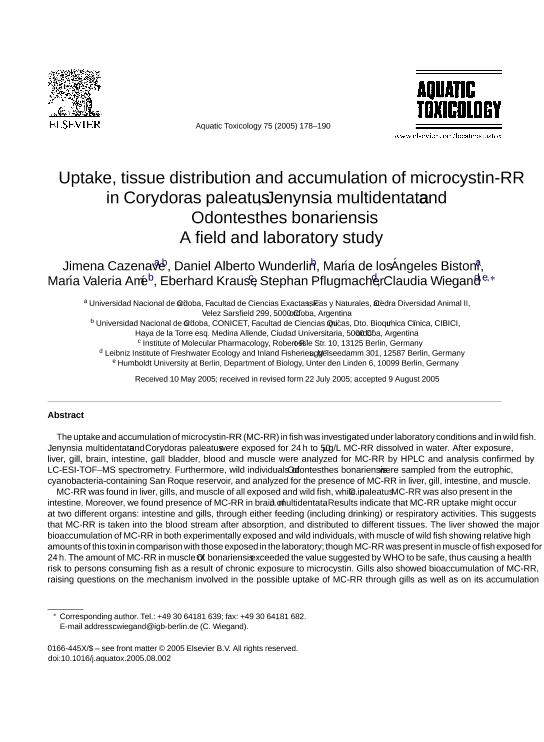Artículo
Uptake, tissue distribution and accumulation of microcystin-RR in Corydoras paleatus, Jenynsia multidentata and Odontesthes bonariensis
Cazenave, Jimena ; Wunderlin, Daniel Alberto
; Wunderlin, Daniel Alberto ; Bistoni, Maria de Los Angeles; Amé, María Valeria
; Bistoni, Maria de Los Angeles; Amé, María Valeria ; Krause, Eberhard; Pflugmacher, Stephan; Wiegand, Claudia
; Krause, Eberhard; Pflugmacher, Stephan; Wiegand, Claudia
 ; Wunderlin, Daniel Alberto
; Wunderlin, Daniel Alberto ; Bistoni, Maria de Los Angeles; Amé, María Valeria
; Bistoni, Maria de Los Angeles; Amé, María Valeria ; Krause, Eberhard; Pflugmacher, Stephan; Wiegand, Claudia
; Krause, Eberhard; Pflugmacher, Stephan; Wiegand, Claudia
Fecha de publicación:
10/2005
Editorial:
Elsevier Science
Revista:
Aquatic Toxicology
ISSN:
0166-445X
Idioma:
Inglés
Tipo de recurso:
Artículo publicado
Clasificación temática:
Resumen
The uptake and accumulation of microcystin-RR (MC-RR) in fishwas investigated under laboratory conditions and in wild fish. Jenynsia multidentata and Corydoras paleatus were exposed for 24 h to 50 µg/L MC-RR dissolved in water. After exposure, liver, gill, brain, intestine, gall bladder, blood and muscle were analyzed for MC-RR by HPLC and analysis confirmed by LC-ESI-TOF–MS spectrometry. Furthermore, wild individuals of Odontesthes bonariensis were sampled from the eutrophic, cyanobacteria-containing San Roque reservoir, and analyzed for the presence of MC-RR in liver, gill, intestine, and muscle. MC-RR was found in liver, gills, and muscle of all exposed and wild fish, while in C. paleatus MC-RR was also present in the intestine. Moreover, we found presence of MC-RR in brain of J. multidentata. Results indicate that MC-RR uptake might occur at two different organs: intestine and gills, through either feeding (including drinking) or respiratory activities. This suggests that MC-RR is taken into the blood stream after absorption, and distributed to different tissues. The liver showed the major bioaccumulation of MC-RR in both experimentally exposed and wild individuals, with muscle of wild fish showing relative high amounts of this toxin in comparison with those exposed in the laboratory; thoughMC-RRwas present in muscle of fish exposed for 24 h. The amount of MC-RR in muscle of O. bonariensis exceeded the value suggested by WHO to be safe, thus causing a health risk to persons consuming fish as a result of chronic exposure to microcystin. Gills also showed bioaccumulation of MC-RR, raising questions on the mechanism involved in the possible uptake of MC-RR through gills as well as on its accumulation in this organ. Although MC-LR has been reported in brain of fish, this is the first report confirming the presence of MC-RR in this organ, which means that both toxins are able to cross the blood–brain barrier. These findings also raise questions on the probable neurotoxicity of microcystins.
Archivos asociados
Licencia
Identificadores
Colecciones
Articulos(ICYTAC)
Articulos de INST. DE CIENCIA Y TECNOLOGIA DE ALIMENTOS CORDOBA
Articulos de INST. DE CIENCIA Y TECNOLOGIA DE ALIMENTOS CORDOBA
Articulos(INALI)
Articulos de INST.NAC.DE LIMNOLOGIA (I)
Articulos de INST.NAC.DE LIMNOLOGIA (I)
Citación
Cazenave, Jimena; Wunderlin, Daniel Alberto; Bistoni, Maria de Los Angeles; Amé, María Valeria; Krause, Eberhard; et al.; Uptake, tissue distribution and accumulation of microcystin-RR in Corydoras paleatus, Jenynsia multidentata and Odontesthes bonariensis; Elsevier Science; Aquatic Toxicology; 75; 2; 10-2005; 178-190
Compartir
Altmétricas



